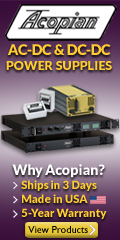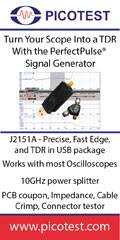 |
|
IN THIS ISSUE:
» How To Drive Rad Hard E-Mode GaN Transistors Efficiently And Safely
» Accelerating UPS Wake-Up Can Improve Power Supply Efficiency
» The Engineer’s Guide To EMI In DC-DC Converters (Part 10): Input Filter Impact on Stability
» Focus On Magnetics:
Flyback Magnetics: Winding-Current Transition Is Key To Efficiency
» Spotlight On Safety & Compliance:
Maintaining Battery Safety And Life Of Battery Are Top Priorities In Battery Charger Design
» New Power Products
» Industry Events:
- Inside ECCE: What’s So Special About A Special Session?
» Other Top Power News
From the Editor's Desk David G. Morrison
Editor, HOW2POWER TODAY

Demand for uninterruptible power supplies (UPSs) in data centers and industrial applications continues to grow with our ever-expanding computing needs. A recent announcement by IHS Markit | Technology predicts that “Edge deployments and cloud and colocation service providers [will] drive [the] global UPS hardware market past $10 billion in 2023.” That’s up from an $8.2 billion market last year, according to the market research firm. With this growth come opportunities to achieve continued improvements in UPS performance, such as higher power supply efficiency. An article by Viktor Vogman in this issue discusses how the use of dc UPSs, a variation on offline or standby UPSs, can help to achieve greater power efficiency in data centers. Specifically, he describes techniques that speed fault detection and UPS wakeup, enabling higher efficiency with dc UPS-based power architectures. Just as the move to higher voltage buses in the data center enables lower power distribution losses, the switch to dc UPS leverages an improvement in system-level power architecture (a reduction in the number of power conversion stages), rather than the improvements in power conversion efficiency that are usually the focus of power supply design. Of course, improvements in power architectures and power supply design go hand in hand, and as new power architectures come into use in the data center, power component and power supply developers will provide the components and converters needed to make those architectures even more efficient. This issue of the newsletter also brings articles discussing the effect of input EMI filters on power converter stability; how to drive rad-hard eGaN power transistors; safety concerns, protection and standards for battery charging; design formulas for coupled inductors in flyback converters; ECCE’s Special sessions; the latest power components and more.
|
|

|
HOW2POWER EXCLUSIVE DESIGN ARTICLES 
|
How To Drive Rad Hard E-Mode GaN Transistors Efficiently And Safely
by Tony Marini and Jim Larrauri, Freebird Semiconductor, Haverhill, Mass.
A portfolio of high reliability, radiation hardened (rad hard) eGAN HEMT devices represents an exciting development for the space circuit design community. These transistors offer the designer a vastly improved Ciss * RDS(ON) figure-of-merit (FOM) as well as much faster switching times when compared to conventional rad hard silicon MOSFETs. Naturally being a newer technology, there are potential interface-related questions about the technology. In particular, designers new to the application of rad hard eGaN HEMT transistors typically want to understand how to deal with the narrower gate-source voltage operating range of the eGaN HEMTs as compared to that of the familiar silicon MOSFETs. For a space-level application design, there are additional complications and this article explains the various factors that influence the choice of the correct gate-source voltage in a space application and how to account for them in designing rad hard gate-drive circuits.
Read the article…
|

Use of a source sense pad on the device
package and minimization of parasitic
inductance in the gate current loop help
to prevent harmful transient voltages
from appearing at the gate terminal of
the HEMT device. |

|

Shortening hold-up time (when the
UPS is switching over to battery
power) creates opportunities for
improving UPS efficiency. |
Accelerating UPS Wake-Up Can Improve Power Supply Efficiency
by Viktor Vogman, Power Conversion Consulting, Olympia, Wash.
For corporate data centers, where downtime is unacceptable and expensive equipment must be protected from power quality problems, standby UPSs are usually insufficient and usage of double conversion (online) UPSs is required. However, recently the standby UPS has expanded its reach in the industry in the form of the dc UPS, which integrates battery backup modules into the server power subsystems. Applying fast fault detection and accelerated redundant power supply wake-up methods developed for servers, the dc UPS wake time can be drastically shortened versus that of the standard offline UPS, even when the battery is not directly interfaced to the dc PDN. This articles explains how speeding up the standby UPS wake-up process creates an opportunity for significant efficiency improvements.
Read the article…
|

 |
 |

The Engineer’s Guide To EMI In DC-DC Converters (Part 10): Input Filter Impact on Stability
by Timothy Hegarty, Texas Instruments, Phoenix, Ariz.
Complying with regulations designed to limit conducted electromagnetic interference (EMI) usually requires the insertion of a low-pass EMI filter between a switching power converter and its source. Part 2 of this EMI article series provided a detailed perspective of noise propagation and the requirement for both differential-mode and common-mode input filtering as an essential part of switching power-supply design. However, dynamic interactions may occur due to a poorly damped EMI filter subsystem when connected to a regulated dc-dc converter. Here in part 10, the interaction between EMI filter and dc-dc converter is addressed including its impact on overall system stability and transient performance. Following an analysis of cascaded systems and the impact of impedance interaction dynamics on stability, this article presents simulation results using a synchronous buck controller with voltage-mode control to illustrate the important characteristics of the stability criteria.
Read the article…
|

Middlebrook established the
foundation of impedance-based
stability and transient-performance
analyses when he published his input
filter design rules for a regulated
converter in continuous conduction
mode (CCM). Others offered more
relaxed criteria for stability. |

FOCUS ON MAGNETICS 
Sponsored by Payton Planar Magnetics
A monthly column presenting information on power magnetics design, products, or related technology |

Flyback Magnetics: Winding-Current Transition Is Key To Efficiency
by Dennis Feucht, Innovatia Laboratories, Cayo, Belize
Flyback converters are isolated PWM-switch common-inductor (CL) configured converters, and a common power supply design choice at low power (<100 W). This article presents, with derivations, the design formulas that apply to flyback converter coupled inductors as part of the magnetics design of the converter. After a brief review of flyback circuit operation and the role of the coupled inductors, the design of the coupled inductors or transductor, is discussed at length.
Read the full article…
|

 |
 |

SPOTLIGHT ON SAFETY & COMPLIANCE 
Sponsored by Power Integrations
A monthly column discussing standards and regulatory requirements affecting power electronics |

Maintaining Battery Safety And Life Of Battery Are Top Priorities In Battery Charger Design
by Kevin Parmenter, Chair, and James Spangler, Co-chair, PSMA Safety and Compliance Committee
Over the years, various rechargeable battery chemistries have been developed including sealed lead acid (SLA), NiCd, NiMH, Li-ion, Li-ion polymer and lithium iron phosphate (LFP or LiFePO4). All of the rechargeable chemistries have advantages and disadvantages, but they’ve all had safety issues related to charging. In this article, we’ll discuss the risks to battery safety and long operating life posed by charging errors, and describe the techniques used in charger design to prevent these errors. We’ll also identify some of the governing standards. This information may be of value both to those designing battery chargers as well as those who are specifying battery charger products.
Read the full article…
|

 |
 |

 — POWER PRODUCTS IN 3 IMAGES OR LESS — POWER PRODUCTS IN 3 IMAGES OR LESS 
|

|

Infineon Technologies’ EVAL-M5-E1B1245N-SiC
evaluation board |
Eval Board Paves Way For SiC MOSFETs In Motor Drives
 Photo: Intended to support design of industrial drives with a max of 7.5-kW motor output, this evaluation board combines an EasyPACK 1B with CoolSiC MOSFET, a three-phase ac connector, an EMI filter, a rectifier and a three-phase output for connecting the motor. This board was developed to help customers take their first steps in designing SiC MOSFETs in motor drives. Photo: Intended to support design of industrial drives with a max of 7.5-kW motor output, this evaluation board combines an EasyPACK 1B with CoolSiC MOSFET, a three-phase ac connector, an EMI filter, a rectifier and a three-phase output for connecting the motor. This board was developed to help customers take their first steps in designing SiC MOSFETs in motor drives.
See the full story… |


 |

|


Teledyne LeCroy’s WaveSurfer 4000HD
High Definition Oscilloscope. |
Oscilloscope Extends 12-bit Resolution To Lower Price Points
 Diagram: With prices starting at $7,490, the WaveSurfer 4000HD High Definition Oscilloscope (HDO) is described as the first in its class to feature 12-bit vertical resolution at all times, displaying clean, crisp waveforms on a bright, 12.1-in. touch screen. The HDO is available in bandwidths from 200 MHz to 1 GHz, with sample rates of up to 5 GS/s and up to 12.5 Mpts of acquisition memory on each of the four channels (25 Mpts interleaved). Diagram: With prices starting at $7,490, the WaveSurfer 4000HD High Definition Oscilloscope (HDO) is described as the first in its class to feature 12-bit vertical resolution at all times, displaying clean, crisp waveforms on a bright, 12.1-in. touch screen. The HDO is available in bandwidths from 200 MHz to 1 GHz, with sample rates of up to 5 GS/s and up to 12.5 Mpts of acquisition memory on each of the four channels (25 Mpts interleaved).
See the full story…
|

ABSOPULSE Electronics’ HVI 41R-F1
dc-dc converter.
|
750-V Input Railway DC-DC Converter Delivers High Efficiency, Long Life
 Photo: Operating from 750 V, the traction voltage required for mass transit vehicles, the HVI 41R-F1 dc-dc converter delivers a regulated 24-V/2-A output or custom output, while achieving a typical efficiency of 85% at full load. The converter is designed for up to 30 years of operating life. Photo: Operating from 750 V, the traction voltage required for mass transit vehicles, the HVI 41R-F1 dc-dc converter delivers a regulated 24-V/2-A output or custom output, while achieving a typical efficiency of 85% at full load. The converter is designed for up to 30 years of operating life.
See the full story…
|

|








|
INDUSTRY EVENTS  |
|
Inside ECCE: What’s So Special About A Special Session?
by Peter Wung, Special Sessions Founder, IEEE Energy Conversion Congress & Exposition (ECCE 2020)
Special sessions have been a mainstay at the IEEE Energy Conversion Congress & Exposition (ECCE) for the last three years. Though the technical program was already packed with well over a hundred oral (paper) sessions, the special session was added to create a synergy between the participants from different segments of the energy conversion industry, i.e. between the students, academics, working engineers and researchers on timely topics. While we like to think that the topics being discussed in the oral sessions are timely, and they generally are, the reality is a bit more complicated.
Read the full story… |

|

OTHER TOP POWER NEWS
|
|
 Another successful Long Island Power Electronics Symposium was recently concluded, drawing a record 475 attendees to hear talks and meet with exhibitors. Another successful Long Island Power Electronics Symposium was recently concluded, drawing a record 475 attendees to hear talks and meet with exhibitors.
 Electronetics, which specializes in providing custom magnetics solutions for a wide variety of medical, aerospace, audio, and industrial applications, will operate as a division of Triad Magnetics, which has more than 75 years of experience designing and manufacturing magnetics. Electronetics, which specializes in providing custom magnetics solutions for a wide variety of medical, aerospace, audio, and industrial applications, will operate as a division of Triad Magnetics, which has more than 75 years of experience designing and manufacturing magnetics.


 Professor Slobodan Ćuk’s “Power Electronics Masterclass” which has been expanded to five days will be offered March 16-20, 2020 at UC Irvine. Professor Slobodan Ćuk’s “Power Electronics Masterclass” which has been expanded to five days will be offered March 16-20, 2020 at UC Irvine.
 Exhibitor registration is now open for the 24th annual Components for Military & Space Electronics Conference and Exhibition (CMSE), which will be held April 21-23, 2020 in Los Angeles. Exhibitor registration is now open for the 24th annual Components for Military & Space Electronics Conference and Exhibition (CMSE), which will be held April 21-23, 2020 in Los Angeles.
 Transphorm recently announced that it has shipped over half a million GaN power devices for multi-kilowatt class applications. Transphorm recently announced that it has shipped over half a million GaN power devices for multi-kilowatt class applications.
 After four years of collaborative efforts between Chengdu OK New Energy (COKNE) and AVX on the manufacturing and development of supercapacitors, AVX has completed the purchase of COKNE and its full vertical integration under the AVX umbrella. After four years of collaborative efforts between Chengdu OK New Energy (COKNE) and AVX on the manufacturing and development of supercapacitors, AVX has completed the purchase of COKNE and its full vertical integration under the AVX umbrella.
|
 |
|  |
ABOUT THIS NEWSLETTER: Thank you for reading HOW2POWER TODAY.
How2Power sends no more than one e-mail per month to registered users. Continuing your subscription ensures you'll receive future newsletters. Manage Your Subscription
©2019 All rights reserved. www.how2power.com
|
|